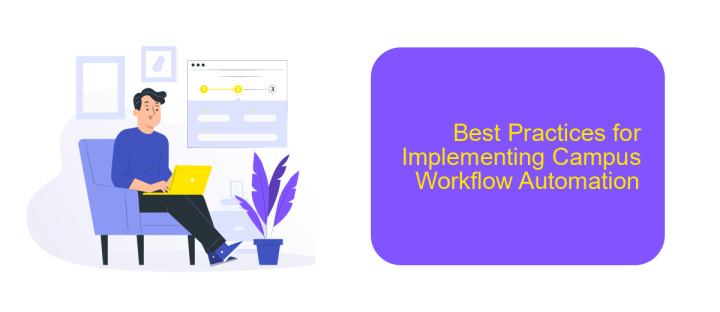Campus Workflow Automation
In the fast-paced environment of modern academia, efficient campus workflow automation has become essential for enhancing productivity and streamlining administrative tasks. By leveraging advanced technology, educational institutions can optimize processes, reduce manual workloads, and improve overall communication. This article explores the benefits, challenges, and best practices for implementing campus workflow automation to create a more effective and responsive educational ecosystem.
Introduction
Campus Workflow Automation is revolutionizing the way educational institutions manage their daily operations. By streamlining processes, reducing manual tasks, and integrating various systems, campuses can operate more efficiently and focus on their primary mission: education. This introduction explores the key benefits and components of campus workflow automation.
- Improved efficiency and productivity
- Enhanced communication and collaboration
- Reduced operational costs
- Increased data accuracy and accessibility
- Better compliance and reporting
One of the essential aspects of campus workflow automation is the integration of various systems and services. Tools like ApiX-Drive facilitate seamless integration between different platforms, ensuring that data flows smoothly and processes are automated effectively. By leveraging such services, campuses can enhance their operational capabilities and provide a better experience for students and staff alike.
Benefits of Campus Workflow Automation

Campus workflow automation significantly enhances operational efficiency by streamlining administrative tasks and reducing manual intervention. Automated processes minimize errors and save time, allowing staff to focus on more strategic initiatives. This leads to improved productivity and a more organized campus environment. Furthermore, real-time data tracking and reporting capabilities enable better decision-making and resource allocation.
Integrating various campus systems through automation platforms like ApiX-Drive ensures seamless data flow and communication between departments. ApiX-Drive simplifies the integration process, allowing institutions to connect multiple applications without extensive coding knowledge. This not only reduces IT workload but also ensures that essential data is synchronized across all platforms, enhancing overall campus management. As a result, campuses can provide a more cohesive and efficient experience for students, faculty, and administrative staff.
Challenges of Implementing Campus Workflow Automation

Implementing campus workflow automation can present several challenges that institutions must navigate to achieve successful integration and operation. These challenges can range from technical issues to human factors, each requiring careful consideration and strategic planning.
1. Technical Integration: Integrating various systems and software can be complex. Services like ApiX-Drive can facilitate seamless integration, but initial setup and configuration may still pose difficulties.
2. Data Security: Ensuring the security and privacy of sensitive information is paramount. Institutions must implement robust security measures to protect against data breaches.
3. User Adoption: Getting faculty, staff, and students to adopt new automated workflows can be challenging. Providing adequate training and support is essential for smooth transitions.
4. Cost: The financial investment required for automation tools and ongoing maintenance can be significant, posing budgetary constraints for some institutions.
5. Customization: Tailoring automation solutions to meet the specific needs of a campus can be time-consuming and may require specialized expertise.
Addressing these challenges requires a comprehensive approach that includes leveraging integration services like ApiX-Drive, implementing stringent security protocols, investing in user training, managing costs effectively, and ensuring that automation solutions are customizable to fit the unique needs of the institution. With careful planning and execution, campuses can overcome these obstacles and reap the benefits of workflow automation.
Best Practices for Implementing Campus Workflow Automation

Implementing campus workflow automation requires careful planning and execution to ensure seamless integration and optimal performance. Start by identifying the key processes that can benefit from automation, such as admissions, student records management, and facility maintenance. By targeting these areas, you can significantly improve efficiency and reduce manual errors.
Next, choose the right tools and platforms that align with your campus's specific needs. ApiX-Drive, for example, offers a robust solution for integrating various applications and automating workflows without the need for extensive coding knowledge. This can simplify the process of connecting disparate systems and streamlining operations.
- Conduct a thorough needs assessment to identify high-impact areas.
- Select user-friendly automation tools that require minimal technical expertise.
- Ensure robust data security and compliance with relevant regulations.
- Provide comprehensive training for staff and stakeholders.
- Regularly monitor and evaluate the system's performance for continuous improvement.
By following these best practices, campuses can effectively implement workflow automation to enhance productivity, reduce operational costs, and provide a better experience for students and staff. Continuous evaluation and adaptation of the automation strategy will ensure long-term success and scalability.
Conclusion
In conclusion, Campus Workflow Automation represents a significant leap forward in streamlining administrative and academic processes within educational institutions. By automating repetitive tasks, reducing manual errors, and enhancing communication channels, campuses can achieve higher efficiency and improved productivity. This transformation not only benefits the administrative staff but also enhances the overall experience for students and faculty members.
Integrating various systems and tools is crucial for the success of workflow automation. Services like ApiX-Drive play a pivotal role in this integration process, allowing seamless connectivity between different platforms and applications. By leveraging such services, campuses can ensure that their automation efforts are comprehensive and cohesive, ultimately leading to a more organized and efficient operational environment. Embracing these technological advancements is essential for educational institutions aiming to stay competitive and provide top-notch services to their communities.
FAQ
What is Campus Workflow Automation?
How can Campus Workflow Automation benefit an educational institution?
What are some common processes that can be automated on a campus?
How can I integrate different campus systems for a seamless workflow?
Is it difficult to implement Campus Workflow Automation?
Apix-Drive will help optimize business processes, save you from a lot of routine tasks and unnecessary costs for automation, attracting additional specialists. Try setting up a free test connection with ApiX-Drive and see for yourself. Now you have to think about where to invest the freed time and money!

